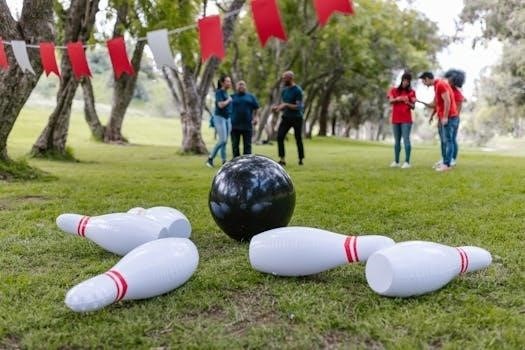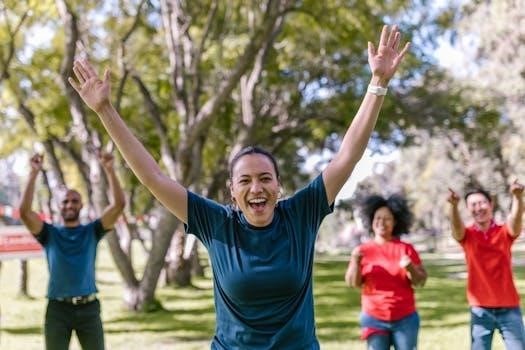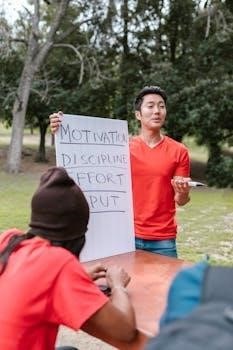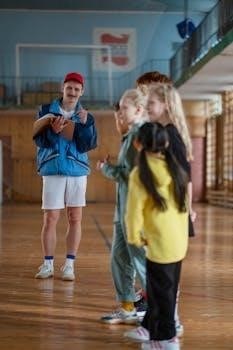
Leadership Training Activities Overview
This section delves into the realm of leadership training, exploring diverse activities designed to enhance crucial skills․ These exercises help both new and experienced leaders grasp concepts like trust, values, and effective communication․ The aim is to foster a deeper understanding of leadership dynamics․
Key Leadership Skills Addressed
Effective leadership hinges on a diverse set of skills, and this section highlights the core competencies targeted by various training activities․ We’ll explore activities aimed at improving communication, a cornerstone of any successful leader․ This includes active listening, clear articulation of ideas, and the ability to provide constructive feedback․ Furthermore, exercises focus on enhancing negotiation skills, enabling leaders to navigate complex situations and reach mutually beneficial agreements․ Conflict resolution is another critical area, where activities guide leaders in addressing disagreements constructively and fostering a positive team environment․ The importance of mentoring is also highlighted, as leaders learn to develop and guide their team members effectively․ We delve into activities designed to strengthen decision-making capabilities, promoting both rational and intuitive approaches․ Additionally, these activities foster better group management skills, enabling leaders to delegate tasks effectively and build cohesive teams․ Finally, this section addresses crucial skills like vision, networking, and understanding diversity, all of which are essential for modern leadership․ This combination of skills ensures that leaders are well-equipped to handle diverse challenges and to lead their teams to success․

Team Building Games for Leadership
This section explores team-building games designed to develop leadership skills․ These games emphasize communication, decision-making, and group management․ The activities aim to foster collaboration and improve team dynamics through interactive and engaging exercises․
Developing Communication Skills
Effective communication is the cornerstone of successful leadership, and various activities can be employed to hone these skills․ One such activity is the “back-to-back drawing” exercise, where participants describe an image to their partner who must then draw it without seeing the original․ This highlights the importance of clear, concise instructions and active listening․ Furthermore, simple icebreaking questions can also be utilized to encourage interaction and open dialogue within a group, fostering a comfortable environment for sharing ideas and perspectives․ The ability to articulate ideas effectively, listen attentively, and provide constructive feedback are crucial aspects of leadership, and these activities are designed to cultivate them․ These exercises are invaluable tools for leaders seeking to establish rapport, build trust, and facilitate collaboration within their teams․ Another helpful activity involves group discussions centered on complex scenarios where participants must convey their thoughts and engage in respectful debate, honing both their verbal and non-verbal skills․ Activities like these help leaders understand how their communication style impacts others․
Enhancing Decision-Making
Effective decision-making is a critical component of strong leadership, and various team-building activities can sharpen this skill․ Games that simulate real-world scenarios, where leaders must weigh options, analyze risks, and make choices under pressure, are particularly valuable․ The ‘What If’ activity, for example, presents a hypothetical situation requiring participants to quickly assess the situation and propose a solution, encouraging critical thinking and collaborative problem-solving․ Furthermore, exercises that involve prioritizing tasks and allocating resources, also help leaders develop the ability to make informed decisions with limited information․ These activities not only enhance the ability to make sound judgments but also foster a sense of responsibility and accountability․ Furthermore, leaders can benefit from exercises that simulate complex situations with multiple stakeholders, allowing them to refine their ability to navigate competing interests and make decisions that benefit the team as a whole․ Through such exercises, leaders learn to analyze situations, evaluate alternatives, and make well-informed choices under pressure․
Improving Group Management
Effective group management is pivotal for successful leadership, and several team-building games can help hone these skills; Activities focusing on delegation, coordination, and conflict resolution are key to developing a leader’s ability to manage a team effectively․ Games that require a group to complete a task under time pressure, such as the ‘All Aboard’ activity, can reveal how well leaders can delegate responsibilities and coordinate team efforts․ Furthermore, exercises that involve navigating disagreements or misunderstandings help leaders develop skills in conflict resolution and creating a harmonious working environment․ Activities that focus on understanding individual strengths and weaknesses within a team allow leaders to make informed decisions about task allocation, ensuring that each member can contribute their best․ Through these activities, leaders learn to motivate team members, manage diverse personalities, and create a unified and productive team․ The ‘Minefield’ exercise, for example, encourages clear communication and trust within the group, essential for effective group management; These exercises develop leaders into effective team managers․

Effective Leadership Exercises
This section highlights practical leadership exercises designed to enhance team performance․ These activities, ranging from survival scenarios to creative challenges, provide hands-on experience in applying leadership skills․ These exercises aim to improve team coordination and problem-solving skills․
Survival Leadership Activities
Survival leadership activities present unique scenarios that push participants to utilize their leadership potential in high-pressure, unfamiliar settings․ These exercises often involve simulated survival situations where teams must collaborate to make critical decisions, allocate resources, and navigate challenges effectively․ These activities are designed to reveal how leaders perform under stress, emphasizing the importance of clear communication, strategic planning, and adaptability․ Furthermore, these scenarios offer insights into how different leadership styles emerge when facing adversity, providing valuable learning opportunities for personal development․ Participants gain experience in quick decision-making, resource management, and effective team communication․ The goal is to create a controlled environment where individuals can explore their leadership capabilities and learn to lead effectively even under pressure․ These activities promote team cohesion and identify potential leaders within the group, highlighting the value of teamwork and shared responsibility․ The lessons derived from survival leadership activities are directly applicable to real-world leadership challenges․
The Marshmallow Challenge
The Marshmallow Challenge is a deceptively simple yet insightful team-building exercise that emphasizes the importance of collaboration, prototyping, and iterative design․ Teams are given a set of materials, such as spaghetti sticks, tape, string, and a marshmallow, and challenged to build the tallest freestanding structure that can support the marshmallow on top․ This activity encourages participants to think creatively, experiment with different approaches, and adapt to unexpected challenges․ It highlights the critical role of planning, communication, and problem-solving within a team dynamic․ Furthermore, it underscores the importance of working together effectively and learning from initial failures․ The Marshmallow Challenge demonstrates how iterative design can lead to better outcomes, as teams learn and adjust their strategies based on their initial attempts․ The activity is not about the end result but rather the process of teamwork, communication, and problem-solving, which are all important leadership qualities․ It provides a practical, hands-on learning experience for participants, making it a valuable tool for leadership development․
Back-to-back Drawing
Back-to-back drawing is a unique communication exercise that highlights the challenges of conveying information accurately and effectively․ In this activity, participants are paired up, sitting back-to-back․ One person is given a picture or a design, and their task is to describe it verbally to their partner, who must then try to draw what they hear without seeing the original image․ This seemingly straightforward task quickly reveals the nuances of communication breakdown, as misinterpretations and assumptions can easily lead to discrepancies between the original picture and the final drawing․ The exercise emphasizes the importance of clarity, active listening, and asking clarifying questions․ It demonstrates how different individuals interpret the same information, underscoring the need for precise and unambiguous communication in leadership roles․ It also highlights the value of feedback and the importance of checking for understanding to ensure that messages are received as intended․ This activity is a powerful tool for improving communication skills and promoting effective leadership․

Leadership Development Resources
This section offers resources for continuous leadership growth․ Explore audio materials and science-based exercises designed to foster positive leadership practices․ These materials can help individuals and organizations thrive by promoting effective leadership․
Audio Resources on Leadership
Engage with a curated selection of audio resources designed to deepen your understanding of leadership principles and practices․ These resources offer a convenient way to learn about leadership while commuting, exercising, or during other downtime․ Explore topics such as “Does Leadership Matter?”, which delves into the significance of leadership in various contexts․ This resource prompts critical reflection on the impact leaders have on teams and organizations․ Another valuable resource is “The Evolution of Leadership Thought,” which traces the development of leadership theories over time․ It offers a historical perspective that can enrich your approach to leadership today․ These audio resources provide expert insights and practical advice, allowing you to learn from thought leaders in the field․ They cover a wide range of subjects, including effective communication strategies, motivational techniques, and conflict resolution methods․ These audio options can cater to various learning styles and schedules, making leadership development more accessible and convenient․ By listening to these resources, you can expand your knowledge base and enhance your leadership skills in a flexible and efficient manner․ These auditory tools are a valuable addition to any leader’s development toolkit․ They provide inspiration, knowledge, and practical techniques that can be immediately applied․
Science-Based Leadership Exercises

This section presents a collection of leadership exercises grounded in scientific research, designed to foster positive leadership practices and enhance organizational effectiveness․ These exercises aim to move beyond anecdotal evidence, providing participants with tools supported by empirical data․ One such exercise is the “Survival Leadership Activities,” which simulates challenging scenarios that test decision-making and teamwork under pressure․ Through such exercises, leaders can learn to adapt quickly and make sound judgments, even in high-stakes situations․ The exercises also include activities like “All Aboard,” which promotes collaboration and strategic thinking, and “What If,” a scenario-planning exercise that encourages leaders to consider various possibilities and prepare contingency plans․ These exercises help improve cognitive flexibility and adaptability․ Also included are “Minefield,” designed to enhance communication and trust, and “Leaders You Admire,” a reflective activity that helps to identify positive leadership traits and behaviors․ The aim is to develop effective leadership skills through practical, science-backed methodologies․ These activities are structured to help leaders understand how their behavior impacts their teams, promoting a culture of growth and continuous improvement․ Incorporating these science-backed methods can lead to more effective and sustainable leadership development․

